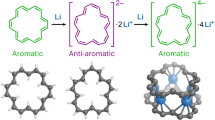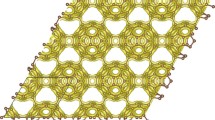Abstract
Smalley and co-workers1 have speculated that an icosahedral C60 molecule might have unusual magnetic properties. Here we report that the π-electron ring-current susceptibility of C60 is unusually small and sensitively dependent on the relative strengths of the two inequivalent bonds of the molecule. For equal bond strengths the susceptibility is only -0.21 that of benzene (with field normal to the plane of the six-membered ring). A 2% change in relative bond strengths is enough to change the sign of the susceptibility with the result that C60 is probably weakly diamagnetic. The shielding effect of the π-electrons is calculated to be less than 1 p.p.m. for an atom placed at the centre of C60. A larger effect is expected for C606-, which is calculated to be strongly diamagnetic.
This is a preview of subscription content, access via your institution
Access options
Subscribe to this journal
Receive 51 print issues and online access
$199.00 per year
only $3.90 per issue
Buy this article
- Purchase on Springer Link
- Instant access to full article PDF
Prices may be subject to local taxes which are calculated during checkout
Similar content being viewed by others
References
Kroto, H. W., Heath, J. R., O'Brien, S. C., Curl, R. F. & Smalley, R. E. Nature 318, 162–163 (1985).
Zhang, Q. L. et al. J. phys. Chem. 90, 525–528 (1986).
Liu, Y. et al. Chem. Phys. Lett. 126, 215–217 (1986).
Bochavar, D. A. & Gal'pem, E. G. Dokl. Acad. Nauk SSSR, Chem., Engl. 209, 239–241 (1972).
Davidson, R. A. Theor. chim. Acta 58, 193–231 (1981).
Haymet, A. D. J. Chem. Phys. Lett. 122, 421–424 (1985); J. Am. chem. Soc. 108, 319–321 (1986).
Klein, D. J., Schmalz, T. G., Hite, G. E. & Seitz, W. A. J. Am. chem. Soc. 108, 1301–1302 (1986).
Newton, M. D. & Stanton, R. E. J. Am. chem. Soc. 108, 2469–2470 (1986).
Disch, R. L. & Schulman, J. M. Chem. Phys. Lett. 125, 465–466 (1986).
Haddon, R. C., Bras, L. E. & Raghavachari, K. Chem. Phys. Lett. 125, 459–464 (1986).
Haddon, R. C. Aust. J. Chem. 30, 1–22 (1977).
Haddon, R. C. J. Am. chem. Soc. 101, 1722–1728 (1979).
London, F. J. Phys. Rad. 8, 397–409 (1937).
Haddon, R. C. J. Am. chem. Soc. (submitted).
Haddon, R. C. Tetrahedron 28, 3613–3634, 3635–3655 (1972).
Kuwajima, S. & Soos, Z. G. J. Am. chem. Soc. 108, 1707–1708 (1986).
DiSalvo, F. J., Safran, S. A., Haddon, R. C., Waszczak, J. V., Fischer, J. E. Phys. Rev. B20, 4883–4888 (1979).
Haigh, C. W. & Mallion, R. B. in Progress in NMR Spectroscopy (eds Emsley, J. W., Feeney, J. & Sutclifle, L. H.) Vol. 13, 303–344 (Pergamon, Oxford, 1979).
Garratt, P. J. Aromaticity (Wiley, New York, 1986).
Salem, L. Molecular Orbital Theory of Conjugated Systems, Ch. 3 (Benjamin, New York, 1966).
Aihara, J.-I. Bull. chem. Soc. Japan 53, 1751–1752 (1980).
McWeeny, R. Molec. Phys. 1, 311–321 (1958).
Elser, V. & Haddon, R. C. Phys. Rev. A (submitted).
Pauling, L. J. chem. Phys. 4, 673–677 (1936).
Author information
Authors and Affiliations
Rights and permissions
About this article
Cite this article
Elser, V., Haddon, R. Icosahedral C60: an aromatic molecule with a vanishingly small ring current magnetic susceptibility. Nature 325, 792–794 (1987). https://doi.org/10.1038/325792a0
Received:
Accepted:
Issue Date:
DOI: https://doi.org/10.1038/325792a0
Comments
By submitting a comment you agree to abide by our Terms and Community Guidelines. If you find something abusive or that does not comply with our terms or guidelines please flag it as inappropriate.



